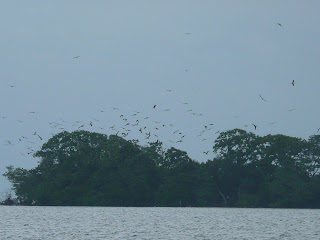
With business and maintenance finished, we headed out to the chain of islands that lies just inside the barrier reef. These islands are mostly mangrove – hard to tell if there’s any actual terra firma there unless there’s a fish camp built on it. There are a lot of fish camps, and a few lodges and small, low-key resorts, and some privately owned cays too.
 Navigation is a challenge. The soundings change abruptly and not for any discernable reason. The charts aren’t much help either. The data is ancient, scale way big, graphics misleading . So it’s strictly eyeball and dead reckoning and keeping track of nearly indistinguishable clumps of mangrove. But the good news is that the air and water are pleasant temperatures, and you can find a different new anchorage often less than an hour away. And if the weather is fine, clear and not too windy, you can see a lot from a perch in the spreaders.
Navigation is a challenge. The soundings change abruptly and not for any discernable reason. The charts aren’t much help either. The data is ancient, scale way big, graphics misleading . So it’s strictly eyeball and dead reckoning and keeping track of nearly indistinguishable clumps of mangrove. But the good news is that the air and water are pleasant temperatures, and you can find a different new anchorage often less than an hour away. And if the weather is fine, clear and not too windy, you can see a lot from a perch in the spreaders.
Our first stop, the Robinson Cays, was a boat building spot in the 19th century but in the 21st, there’s a fish farming operation. It looks well-capitalized. Rumor has it a Swedish group is involved, and that the fry are flown in from there with an 18-hour re-splash window. The fish are cobia, which in my fish book are on the same page as remoras and sharksuckers. They eat pellets made from other fish, so exactly what benefit accrues where, if any, is unclear. Our local informant says the meat is mighty nice, but they’re not allowed to take for themselves.
Our next stop featured a family of manatees feeding 150 feet from the boat, but when I went to visit them underwater I found it so churned up I had a hard time telling which way was up. It’s not easy to photograph a manatee either.
The Fly Range had flies, and the Mosquito Range had mosquitoes (but not many), and Man of War Cay is famous in aviary circles as a refuge for frigate birds. These large and generally solitary birds are known for rarely if ever landing, but I don’t think they can do the egg thing aloft. There are also Brown Boobies and White-Headed Pigeons using this island. How would you like to attend one of those parties!
 A nearly universal rule of travel is: “This is very unusual weather for this time of year.” The fronts that traverse the US often drag tails through the Western Caribbean – the front dumping snow on the US East recently at once point extended from Nova Scotia to Colombia. “They” say it’s been very cool and rainy here this winter. I say it’s been coolish and cloudy, sometimes windy, and not from normal directions.
A nearly universal rule of travel is: “This is very unusual weather for this time of year.” The fronts that traverse the US often drag tails through the Western Caribbean – the front dumping snow on the US East recently at once point extended from Nova Scotia to Colombia. “They” say it’s been very cool and rainy here this winter. I say it’s been coolish and cloudy, sometimes windy, and not from normal directions.
